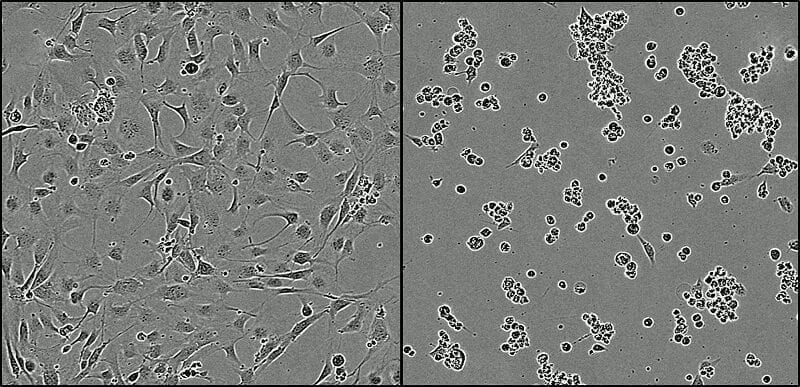
What’s the secret to aging well? University of Minnesota Medical School researchers have answered it- on a cellular level.
Aging starts in our cells, and those aging cells can hasten cellular senescence, leading to tissue dysfunction and related health impacts.
New research involving University of Minnesota Medical School faculty Paul D. Robbins and Laura J. Niedernhofer, recently published in Nature Medicine, shows there are types of small molecules called senolytics that can reverse the impact of aged, senescent cells.
“We’ve always thought of aging as a process, not a disease,” said Dr. Robbins, Associate Director of the newly founded Institute on the Biology of Aging and Metabolism (iBAM). “But what if we can influence the impacts of aging at a cellular level to promote healthy aging? That’s what senolytics seeks to achieve.”
The research determined whether introducing senescent cells to human and animal tissue would impact the cellular health of surrounding cells. Surprisingly, the transplant of a relatively small number of senescent cells caused persistent physical dysfunction as well as the spread of cellular senescence in previously healthy cells.
In addition, researchers found that a high fat diet, which causes a type of metabolic stress, or simply being old, enhances the physical dysfunction that comes from senescent cells.
“Previous research has shown that our immune system’s ability to eliminate or deal with senescent cells is based 30 percent on genetics and 70 percent on environment,” said Dr. Robbins, noting that what we eat and how often we exercise can affect senescence or aging of cells.
Conversely, the researchers determined that treatment with senolytic drugs, able to eliminate senescent cells, can reverse physical dysfunction and actually extend lifespan even when used in aged animal models.
“We saw greater activity, more endurance, and greater strength following use of senolytics,” said Dr. Robbins.
The paper notes that the results provide proof-of-concept evidence that improved health and lifespan in animals is possible by targeting senescent cells. The hope is that senolytics will prove effective in alleviating physical dysfunction and resulting loss of independence in older adult humans as well.
“This area of research is promising, not just to address the physical decline that comes with aging, but also to enhance the health of cancer survivors treated with radiation or chemotherapy – two treatments that can induce cell senescence,” said Laura Niedernhofer, Director of iBAM.
Learn more: University of Minnesota Medical School Research Shows It’s Possible to Reverse Damage Caused by Aging Cells
The Latest on: Senolytic drugs
[google_news title=”” keyword=”senolytic drugs” num_posts=”10″ blurb_length=”0″ show_thumb=”left”]
via Google News
The Latest on: Senolytic drugs
- Alcohol and Drug Counseling Certificateon April 25, 2024 at 7:07 pm
Discover learning that fits your life. In Bethel’s Alcohol and Drug Counseling Certificate program, you’ll be prepared to begin a career helping others overcome addiction. Our program focuses on up-to ...
- UNITY Biotechnology Announces Upcoming Presentations at the ARVO 2024 Annual Meetingon April 25, 2024 at 1:00 am
Senolytic drug candidate in wet AMD demonstrates benefit with Multifocal ERG testing Posterboard Number: B0391 Date & Time: Wednesday, May 8, 2024 at 2:15 – 4:00 p.m. PDT Drug and biotech companies ...
- Cellular atlas identifies six types of senescenceon April 23, 2024 at 5:00 pm
A computational program based on single-cell transcriptome sequencing has identified six types of senescent cells, enabling the design of more precise senolytic drugs. The success of these compounds ...
- Drug shortages reach record high in USon April 12, 2024 at 12:32 pm
There are more active drug shortages in the United States than ever, according to data from the American Society of Health-System Pharmacists and the University of Utah Drug Information Service.
- Hundreds of drugs are in short supply around the U.S., pharmacists warnon April 11, 2024 at 2:49 pm
A growing number of drugs are in short supply around the U.S., according to pharmacists. In the first three months of the year, there were 323 active medication shortages, surpassing the previous ...
- Otezla vs. Humira: What You Should Knowon April 9, 2024 at 5:00 pm
Otezla (apremilast) and Humira (adalimumab) are prescription drugs used to treat plaque psoriasis and psoriatic arthritis in adults. Otezla comes as an oral tablet, and Humira comes as a liquid ...
- Many cancer drugs remain unproven years after FDA's accelerated approval, study findson April 8, 2024 at 7:31 am
The U.S. Food and Drug Administration's accelerated approval program is meant to give patients early access to promising drugs. But how often do these drugs actually improve or extend patients' lives?
- Teen Drug Use Habits Are Changing, For the Good. With Caveats.on April 5, 2024 at 5:00 pm
Dr. Nora Volkow, who leads the National Institutes of Drug Abuse, would like the public to know things are getting better. Mostly. By Matt Richtel Historically speaking, it’s not a bad time to ...
- How AI is changing drug developmenton April 2, 2024 at 4:59 pm
Drug developers are seeking to speed up the testing and developing of new drugs with the help of artificial intelligence (AI). Researchers at universities and pharmaceutical giants are testing how ...
via Bing News











